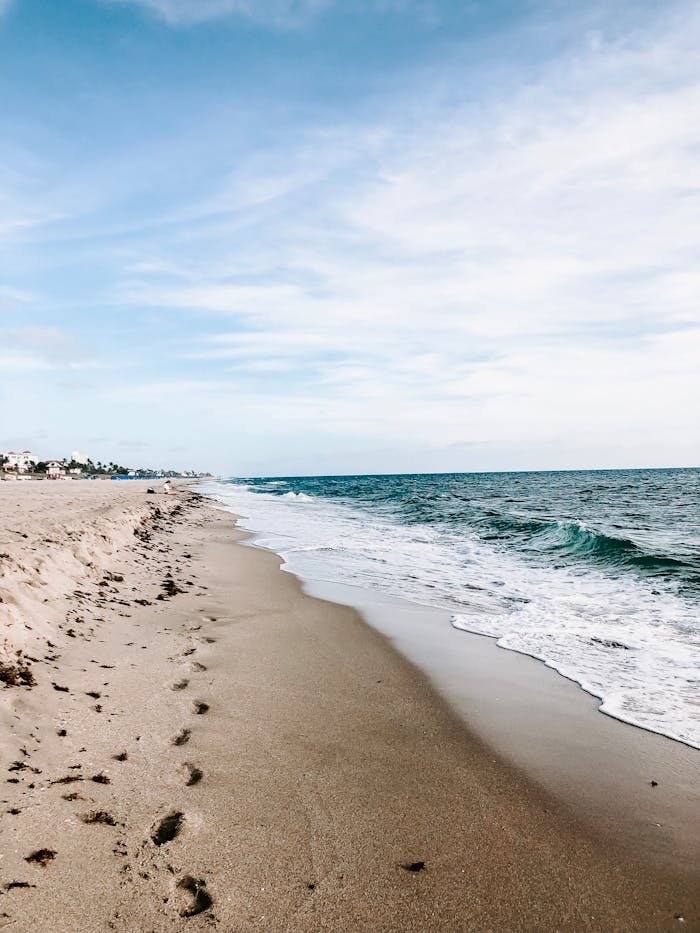As you explore the sun-kissed coast of Florida, you'll discover a diverse array of beach palms, with over 20 species thriving in the state's subtropical climate. Each palm plays a vital role in shaping the unique ecosystems that line the shores, providing habitats for coastal wildlife and protecting shorelines from erosion. From the tall, slender Royal Palm to the compact, adaptable Pindo Palm, you'll find a fascinating variety of shapes and sizes. As you learn more about these incredible plants, you'll uncover the intricate relationships between beach palms, the wildlife they support, and the ecosystems they define.
Key Takeaways
- Beach palms in Florida are a diverse group of palm species adapted to coastal environments, providing habitats for wildlife and protecting shorelines.
- Florida is home to a variety of palm tree species, including Royal Palm, Coconut Palm, Sabal Palm, and Pindo Palm, each with unique characteristics.
- Beach palms thrive in sunny, well-drained areas with abundant coastal vegetation, and are found in coastal counties across Florida.
- Climate change poses a significant threat to beach palms in Florida, causing erosion, increased storm frequency, and rising sea levels that threaten their roots.
What Are Beach Palms
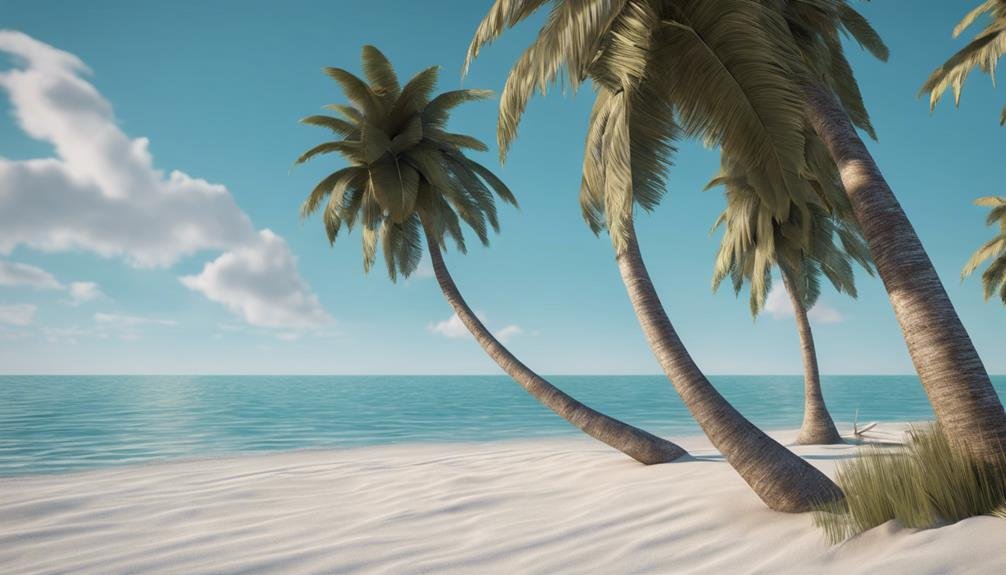
As you stroll along Florida's sun-kissed shores, you'll likely encounter a variety of palm species that have adapted to thrive in the state's coastal environment, but what exactly are these resilient beach palms that have become synonymous with the Sunshine State's iconic landscapes?
You're not alone in wondering about these majestic trees that seem to embody the carefree spirit of Florida's beaches. Beach palms are a diverse group of palm species that have evolved to withstand the harsh conditions of coastal living, from salt-laden winds to shifting sands.
You'll notice that beach palms come in a range of shapes, from the tall, slender profiles of the Sabal palm to the shorter, more compact shapes of the Paurotis palm. But their uses extend far beyond their aesthetic appeal.
Beach palms provide vital habitats for coastal wildlife, protect shorelines from erosion, and even serve as natural windbreaks. Whether you're a native Floridian or just visiting, you can't help but feel a sense of connection to these incredible trees that call the Sunshine State home.
Characteristics of Palm Trees
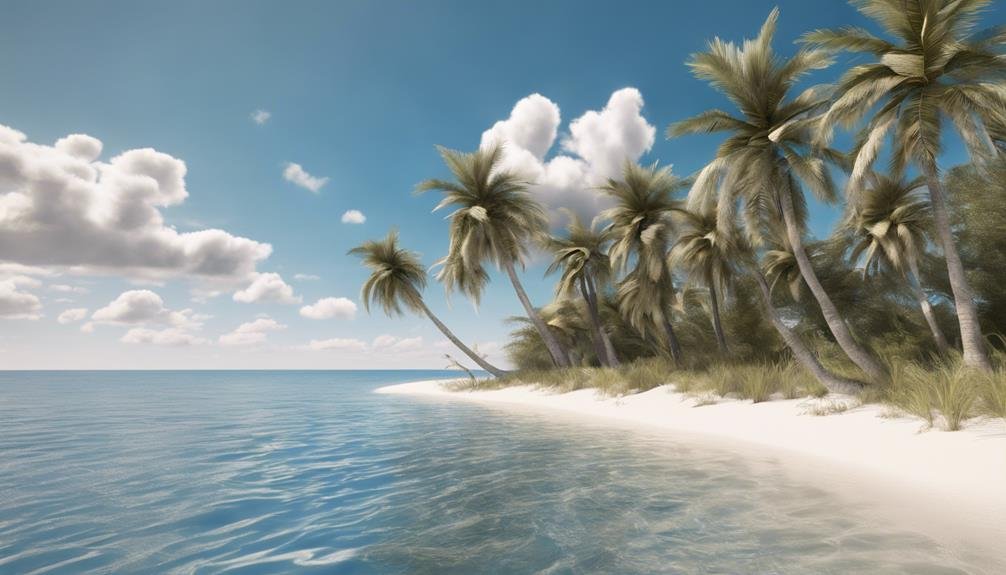
As you begin to explore the wonderful world of beach palms in Florida, you'll quickly notice the unique characteristics that set these trees apart.
You'll see a variety of palm tree types, each with its own distinct features and growth habits that have adapted to the coastal environment.
Types of Palm Trees
Strolling along Florida's beaches, you'll notice a diverse range of palm trees swaying in the breeze, each with its unique characteristics, shapes, and sizes that set them apart from one another. This palm species diversity is a result of Florida's subtropical climate, which allows many palm species to thrive.
As you explore the beach, you'll discover that some palms are tall and slender, while others are short and stout.
You'll also notice the different ways that palms reproduce. Some palms rely on wind pollination, while others use insects or even bats to transfer pollen. This variety of palm pollination methods ensures that each species can thrive in its environment.
Royal Palm: With its majestic trunk and feathery leaves, the royal palm is a striking sight.
Coconut Palm: This palm is famous for its delicious fruit, which is a staple of tropical cuisine.
Sabal Palm: Also known as the cabbage palm, this native Florida species is prized for its edible hearts.
Pindo Palm: With its silvery leaves and vibrant yellow flowers, the pindo palm is a beachside beauty.
Palm Tree Growth Habits
Because palms have adapted to thrive in a variety of environments, you'll notice that each species exhibits unique growth habits that enable it to flourish in Florida's beach ecosystems.
As you stroll along the beach, you'll see that some palms grow tall and slender, while others remain short and stout. You'll notice that the leaf production cycle varies among species, with some palms producing new leaves constantly, while others only produce new growth during specific times of the year.
As you explore the world of beach palms, you'll also discover that each species has distinct nutrient requirements. Some palms thrive in nutrient-rich soils, while others can tolerate poor soil conditions. Understanding these nutrient requirements is crucial for healthy palm growth, and it's essential to choose palms that are well-suited to the local soil conditions.
Habitat and Distribution Range
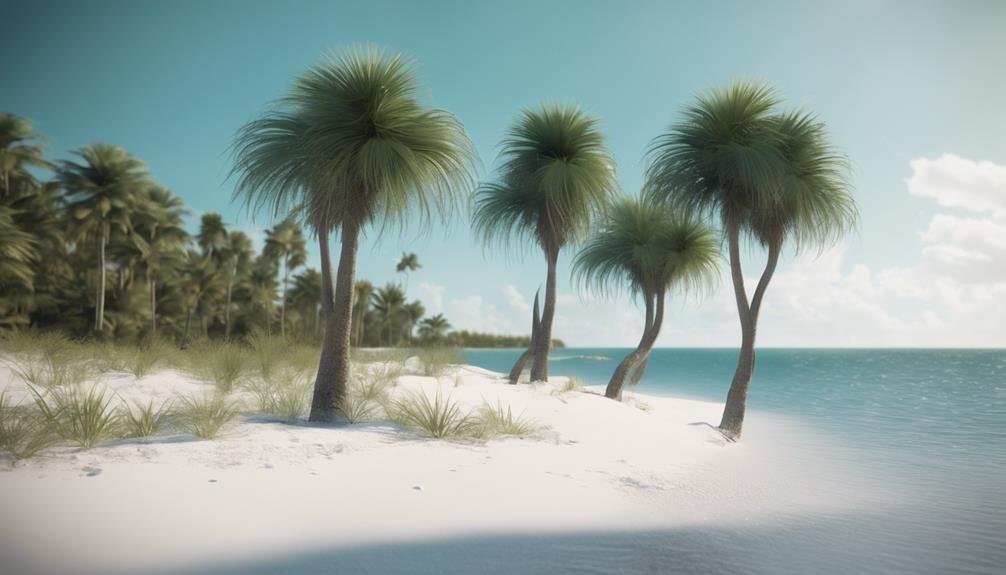
You'll find beach palms thriving in natural growth environments along Florida's coastline, where they've adapted to tolerate salt spray, shifting sands, and full sun.
As you explore the Sunshine State's shores, you'll notice that certain palm species are native to specific geographic regions, such as the saw palmetto in central and southern Florida.
You'll also discover that these resilient palms have climate zone adaptations that allow them to flourish in a range of conditions, from tropical to subtropical.
Natural Growth Environments
Along the sun-kissed shores and mangrove forests of Florida, beach palms thrive in a variety of natural growth environments, often sprouting up in sandy dunes, on shell-filled islands, and in tidal marshes. You'll find them growing in areas with full sun to partial shade, where the soil is well-drained and rich in nutrients. Beach palms are highly adaptable and can tolerate a range of conditions, from drought to flooding, making them a vital part of Florida's plant diversity.
Beach palms can even tap into alternative water sources, such as groundwater or rainfall, allowing them to thrive in areas with limited freshwater resources.
As you explore the natural growth environments of beach palms, you'll discover:
- The way they sway gently in the ocean breeze, their leaves rustling softly
- The sight of their tall, slender trunks rising from the sand like sentinels
- The feeling of shade and shelter they provide from the scorching sun
Native Geographic Regions
From the Panhandle to the Keys, beach palms can be found growing wild in almost every coastal county in Florida, their native geographic range sprawling across a diverse landscape of barrier islands, estuaries, and mangrove shorelines.
As you explore these beautiful regions, you'll notice that beach palms thrive in areas where coastal vegetation is abundant. These areas provide the perfect conditions for the palms to grow, with a mix of sandy dunes, tidal flats, and mangrove forests.
Beach palms play a crucial role in maintaining the health and balance of beach ecosystems. They provide a natural barrier against storms and erosion, and their deep roots help to stabilize the soil.
You'll find that these palms are an integral part of the coastal vegetation, growing alongside other native plants such as sea oats, beach morning glories, and mangroves.
As you immerse yourself in these breathtaking environments, you'll begin to feel a deep connection to the natural world, and a sense of belonging to the land and its rhythms. By exploring the native geographic regions of beach palms, you'll gain a deeper appreciation for the beauty and diversity of Florida's coastline.
Climate Zone Adaptations
As the native geographic range of beach palms spans the diverse coastal landscape of Florida, their ability to thrive in varying climate zones is a testament to their remarkable adaptability, allowing them to occupy a wide range of habitats. You'll find them growing in coastal dunes, mangrove swamps, and even in salt marshes.
Beach palms can tolerate high humidity levels, making them perfect for Florida's subtropical climate. Yet, they also have drought resistance, allowing them to survive during dry spells.
They can thrive in areas with frequent salt spray, yet can also grow in freshwater environments.
Their deep root system allows them to tap into underground water sources, making them resistant to drought.
They can survive in a variety of soil types, from sandy dunes to muddy mangrove swamps.
Their flexible trunks allow them to bend in strong winds, making them resilient to storms and hurricanes.
Impact of Climate Change
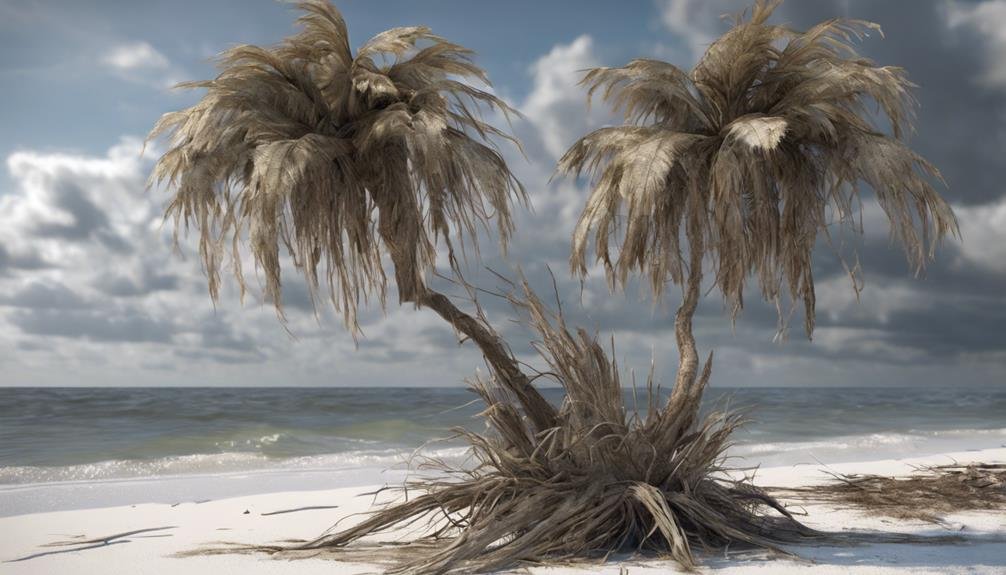
As you explore Beach Palms in Florida, you're witnessing the impact of climate change firsthand. Rising global temperatures are altering the delicate ecosystem of Beach Palms in Florida, where warmer waters and increasingly frequent hurricanes are taking a devastating toll on these majestic trees.
Beach Palms are incredibly resilient, but they're not immune to the effects of rising sea levels and increased storm frequency. As the ocean creeps closer to shore, the roots of these palms are being slowly eroded, making them more vulnerable to strong winds and flooding.
It's heartbreaking to see these iconic trees toppling over, their trunks snapped like twigs. You can't help but wonder what the future holds for these beloved palms. As the storms intensify, the palms are facing unprecedented stress, and their very existence is under threat.
You feel a sense of urgency to act, to protect these natural wonders from the ravages of climate change. Will you join the fight to preserve Beach Palms in Florida?
Conservation Efforts in Florida
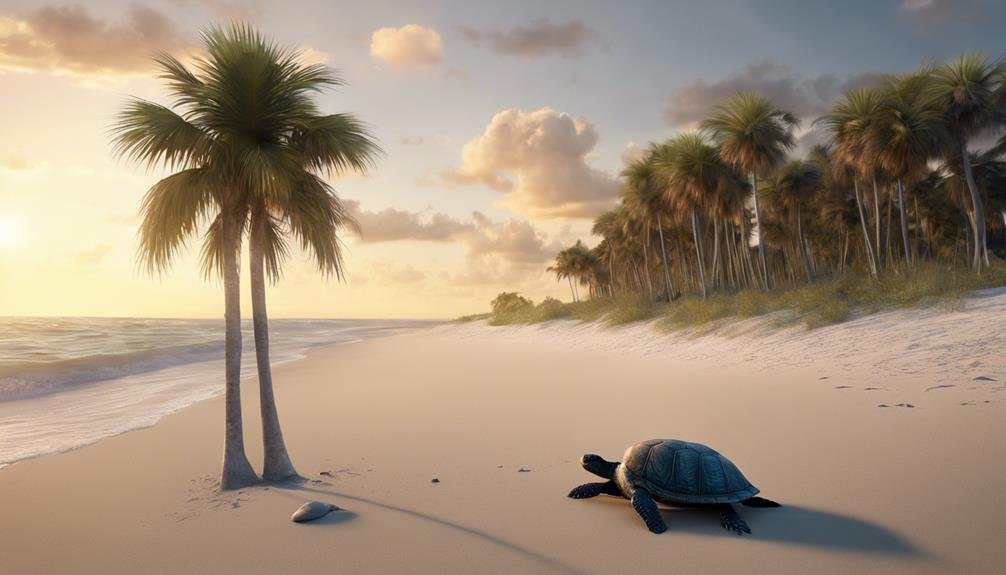
Some promising initiatives are underway to protect Beach Palms in Florida, and you can be part of the solution by supporting organizations that are working tirelessly to conserve these iconic trees and the ecosystems they inhabit.
By joining forces with local preservation initiatives, you'll be contributing to the protection of Beach Palms and the rich biodiversity they support.
You'll be helping to safeguard the homes of countless species that depend on Beach Palms for survival.
Your support will contribute to research and education programs that promote the importance of Beach Palm conservation.
You'll be part of a community that's pushing for legislative protection of these incredible trees and the ecosystems they inhabit.
Together, we can ensure the long-term health and resilience of Beach Palm ecosystems in Florida.
Importance of Palm Preservation

Preserving Beach Palms isn't just a matter of saving a few trees – it's about protecting an entire ecosystem that relies on these iconic palms for survival. As you wander along Florida's coastline, you're not just enjoying a scenic view; you're part of a delicate balance that sustains life. By preserving Beach Palms, you're also safeguarding the homes of countless creatures, from tiny crabs to majestic shorebirds.
Your role in preserving these palms matters more than you think. Every action you take, whether it's choosing sustainable tour operators or respecting protected areas, contributes to the ecosystem's preservation.
Sustainable tourism, in particular, holds a significant key to this puzzle. By supporting businesses that prioritize the environment and engage in eco-friendly practices, you're casting a vote for the long-term survival of these precious Beach Palms.
Conclusion
As you walk along Florida's shores, the beach palms stand tall, like nature's sentinels.
Like the Greek mythological Dryad trees, they're intricately tied to their surroundings. But their beauty belies the struggle they face from climate change.
Conservation efforts are a lifeline, but your role is vital too. Will you join the chorus of protectors, echoing the timeless wisdom of Walt Whitman, 'Do I contradict myself? I contain multitudes' – including the urge to safeguard these stunning trees?

